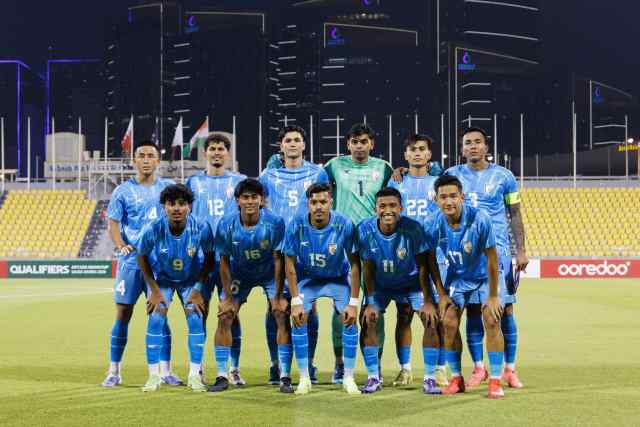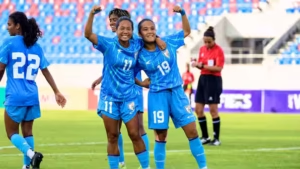The year 2025 has been hailed as one of Indian football’s most successful years at the regional level, with age-group national teams securing dominance across South Asian Football Federation (SAFF) competitions.
India clinched three youth championships Men’s U17, Women’s U17, and Men’s U19 and shared a contentious joint title in the Women’s U19 category. This “near-quadruple sweep” underscores the strength of India’s developmental pipeline, particularly under the guidance of coach Bibiano Fernandes, while also revealing structural weaknesses in governance and the rising challenge posed by Bangladesh.
Framing the 2025 SAFF Narrative
While many celebrated this as a “SAFF domination,” it is more accurate to frame 2025 as a near-quadruple sweep rather than absolute control. India did not contest the Men’s Senior Championship in 2025 – that tournament was scheduled in Sri Lanka later in the year. India’s ninth senior SAFF title, often cited in connection with 2025, had actually been won in 2023. Thus, the narrative of sweeping across all age groups applies primarily to the youth categories.

Even here, success came with caveats. The Women’s U19 crown was shared with Bangladesh after a controversial penalty shootout debacle. Still, with three clear trophies and one shared, 2025 reflects one of the most successful years in Indian youth football.
Men’s U17 Championship: Blue Colts Extend Their Reign
The Men’s U17 team, known as the Blue Colts, extended their dominance by winning a seventh SAFF U17 title in Colombo on September 27. The final against Bangladesh was emblematic of the rivalry that now defines South Asian football.
India led 2-1 at halftime through goals from Dallalmuon Gangte (4’) and Azlaan Shah Kh (38’). Yet Bangladesh equalized deep into stoppage time (90+7’) to force a penalty shootout. India’s composure held, converting four penalties to Bangladesh’s one, with goalkeeper Manashjyoti Baruah producing critical saves.
This marked India’s fifth consecutive U17 SAFF crown, establishing remarkable consistency at the developmental level.
Women’s U17 Championship: Statistical Supremacy
In Thimphu, Bhutan, the Women’s U17 team secured their third SAFF crown with dominant performances in a league format. India topped the table with 15 points, two ahead of Bangladesh.
The numbers told the story: five wins from six matches, 30 goals scored, and only four conceded. A 7–0 thrashing of Nepal and an 8–0 rout of Bhutan highlighted the gulf in quality.
Anushka Kumari finished as top scorer with eight goals, while Abhista Basnett was named Player of the Tournament. Coach Joakim Alexandersson credited teamwork, discipline, and tactical flexibility for the win.
Men’s U19 Championship: Fourth Title, First of Bibiano’s Double
The Men’s U19 team added a fourth title to their history with a penalty shootout victory over Bangladesh in Arunachal Pradesh. The final ended 1-1 in regulation, with Shami Singamayum scoring both India’s goal and the decisive penalty in the 4-3 shootout win.

This was the first of two SAFF crowns secured by Bibiano Fernandes in 2025, the other being the U17 title. Fernandes’ ability to deliver across age categories reflects the success of India’s standardized coaching philosophy, emphasizing tactical discipline and mental toughness.
Women’s U19 Championship: Controversy Overshadows Success
The Women’s U19 final in Dhaka highlighted both India’s competitiveness and SAFF’s governance weaknesses. India and Bangladesh were locked 1-1 after extra time. The shootout stretched to an unprecedented 11-11 before organizers declared India winners by a coin toss.
Bangladesh lodged an immediate protest, noting that coin tosses were not part of tournament rules. Officials reversed the decision, declaring joint winners.
While the result still gave India a fourth Women’s U19 title, the controversy tarnished the achievement. It exposed gaps in tournament regulations and highlighted the need for clearer governance structures within SAFF competitions.
Across all four youth finals, Bangladesh emerged as the primary rival: runners-up in Men’s U17, Women’s U17, and Men’s U19, and joint champions in Women’s U19.
This trend demonstrates that India no longer enjoys uncontested dominance in South Asia. Matches are tighter, margins smaller two finals were decided on penalties, one on league points, and one ended in a governance controversy. Bangladesh’s consistent challenge suggests regional football is rising, and India must continually evolve to maintain an edge.
Women’s Football: Growth Beyond SAFF
India’s women’s youth successes in 2025 translated into continental opportunities. Along with Bangladesh, India qualified for the AFC Women’s Asian Cup 2026 the first time in 27 years that SAFF will have two representatives. This reflects the growing strength of women’s football across South Asia, boosted by FIFA development initiatives and grassroots expansion.
For India, these victories are an early sign that women’s football could provide international breakthroughs, provided pathways are strengthened.
Ironically, India’s youth dominance coincided with turbulence at the domestic professional level. The Indian Super League (ISL) announced it would pause the 2025–26 season due to uncertainty over the Master Rights Agreement (MRA) between the AIFF and FSDL. The Supreme Court had ordered that the AIFF not finalize new terms until constitutional disputes were resolved.
This raised a paradox: while youth teams delivered historic titles, their professional pathways were under threat. Without a functioning ISL or stable I-League, the transition from U17 and U19 success to senior national relevance risks being blocked.
Strategic Lessons from the SAFF Sweep
Coaching Continuity Pays Off: Fernandes’ dual success proved the value of standardized coaching and tactical consistency across age groups. India must codify his “Blue Colts Model” and roll it out nationally.
Mental Toughness Under Pressure: Two penalty shootout wins show Indian youth teams can handle pressure. This composure is essential for AFC and FIFA-level competitions.
Rivalry-Driven Growth: Bangladesh’s rise is good for Indian football. Regular high-intensity battles prepare players for continental challenges, provided India avoids complacency.
Governance Must Catch Up: The U19 Women’s coin-toss fiasco exposed SAFF’s weak regulation. AIFF must lead reforms to ensure rulebooks are airtight and consistent.
Professional Pathway is Critical: Youth success means little without ISL/I-League continuity. Resolving legal disputes and stabilizing professional leagues is urgent to avoid wasting a golden generation.
India’s near-quadruple sweep in 2025 showcased dominance in youth football, proof that the country’s grassroots systems and coaching strategies are maturing. Yet, the sweep also revealed three realities: the narrowing margins of victory, the administrative fragility of South Asian football, and the instability of India’s professional structure.
For India to translate regional supremacy into continental and global progress, two priorities stand out: stabilizing governance and infrastructure, and investing in higher-level exposure beyond SAFF. Winning SAFF trophies may inspire confidence, but the real challenge lies in competing with Japan, South Korea, and West Asian powers at the AFC level.
2025 was a milestone year but only if India uses this momentum to build a bridge from regional promise to continental relevance.
How useful was this post?
Click on a star to rate it!
Average rating 5 / 5. Vote count: 2
No votes so far! Be the first to rate this post.






